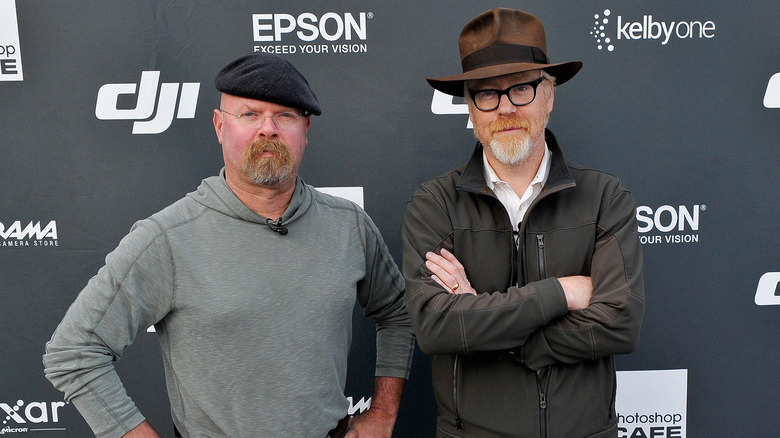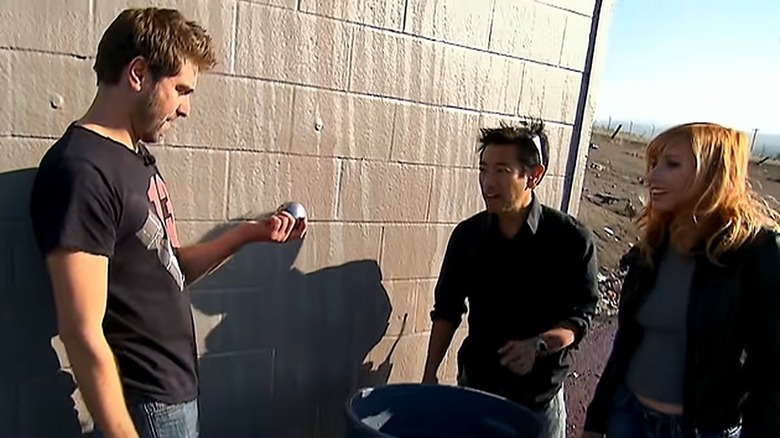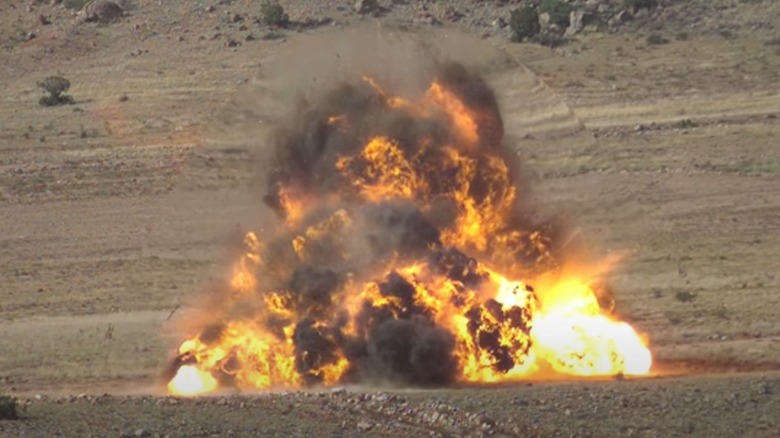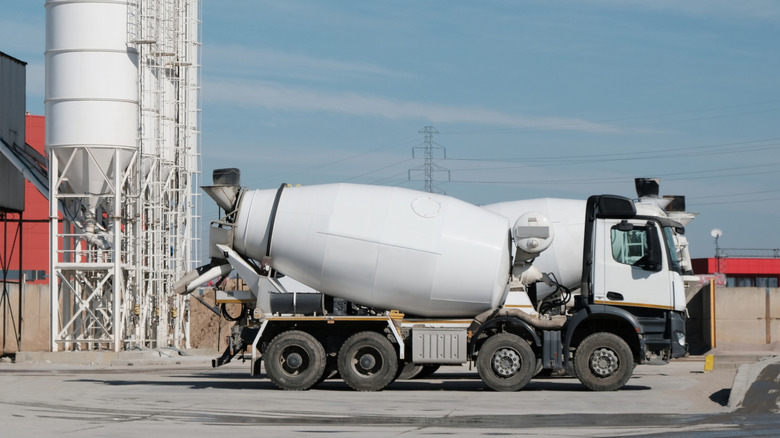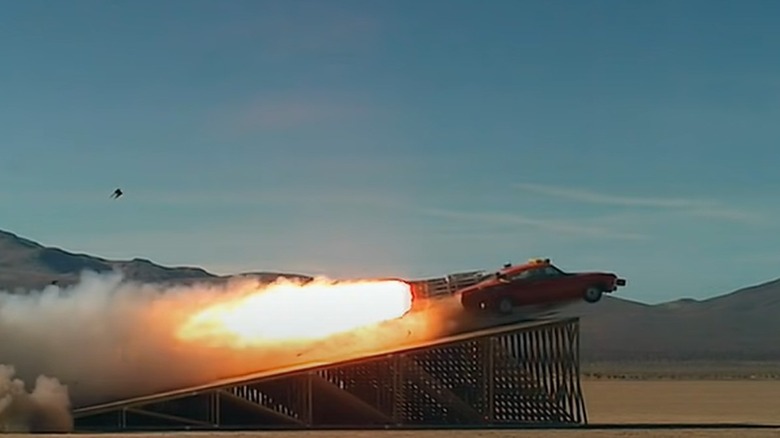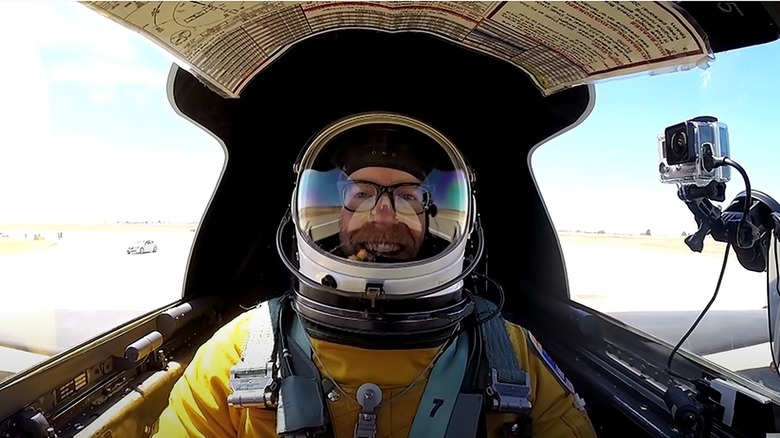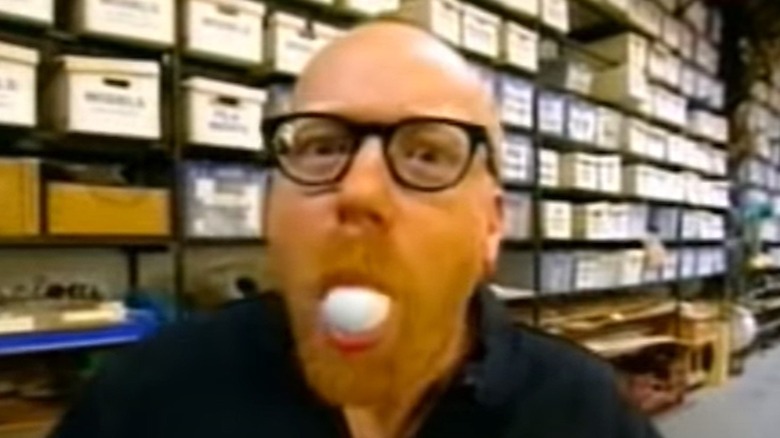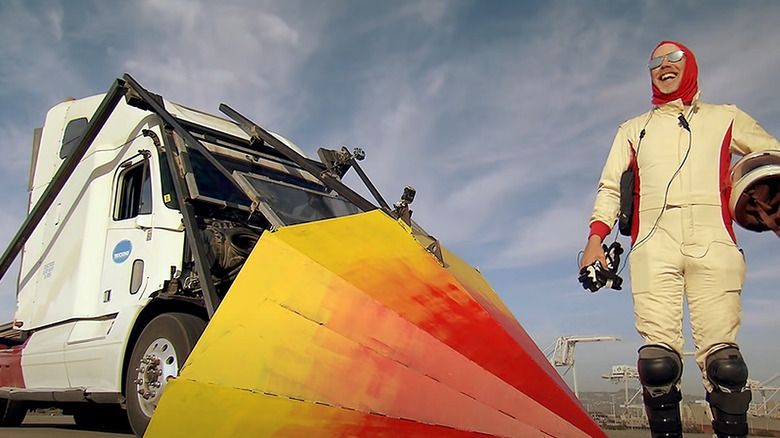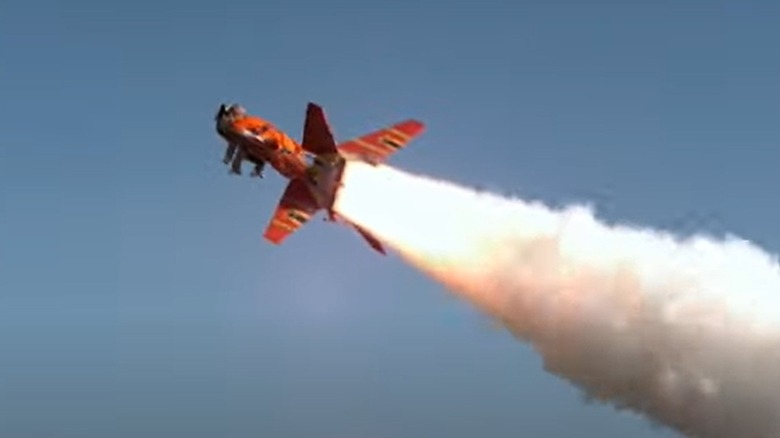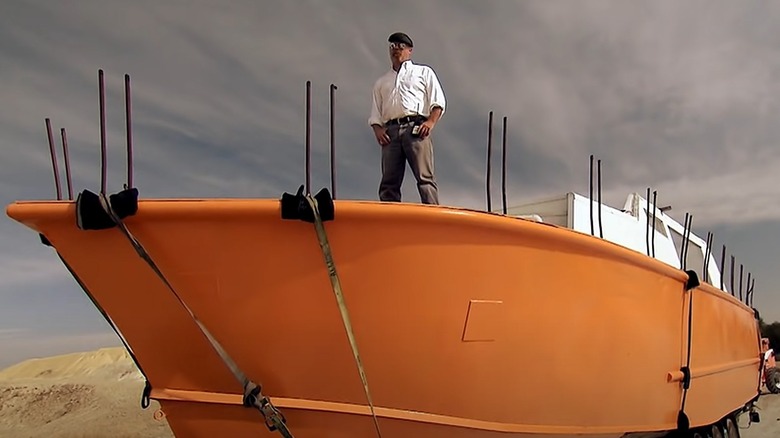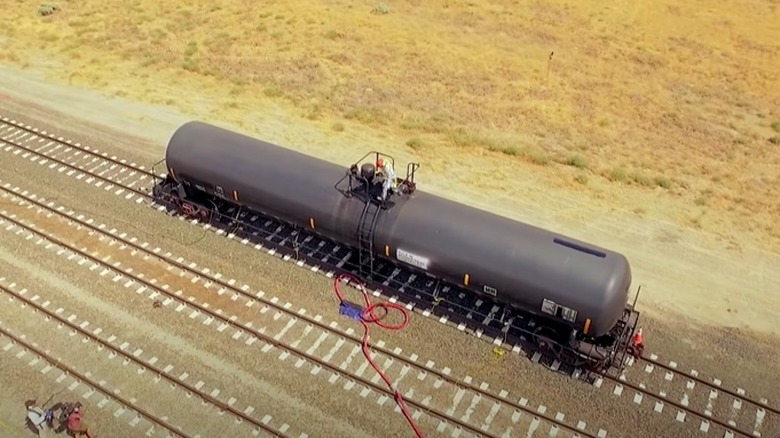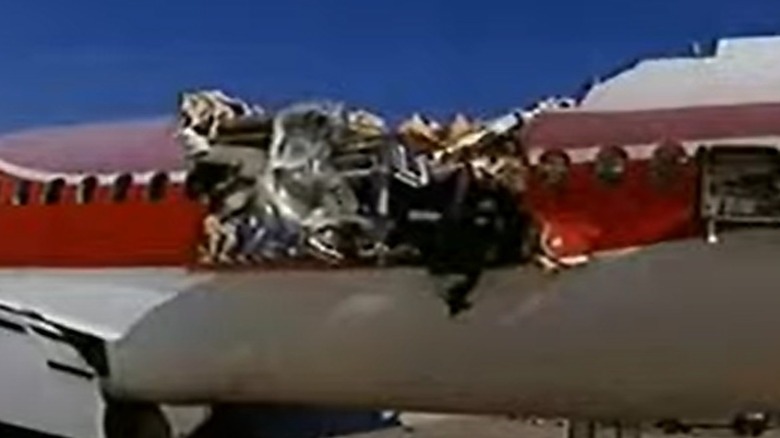The Most Expensive Myths Tested On MythBusters
Watching "MythBusters" as a kid could make you curious about science, the possibilities and wonders in the world, and of course, explosions. This ability the program had to encourage people to take an interest in the scientific method was one of the reasons co-host Adam Savage started "MythBusters Jr." in 2019, according to NPR. Savage is no stranger to costly personal science projects, and he even spent 14 years and more than $15,000 making his own spacesuit for Comic-Con, as CNBC reported.
Watching the show as an adult, though, comes with more nuanced realizations, like the fact that Savage and co-host, Jamie Hyneman, genuinely didn't get along, as Savage told Business Insider, and that busting some of these myths must have cost major moolah. Over the course of Savage and Hyneman's 14-year run, the show that started out with their most expensive myth, according to Neil deGrasse Tyson's "StarTalk" podcast, had some pricey projects throughout the years. Savage and Hyneman have been noticeably silent over the years as to the actual costs realized with their experiments. However, with the time, materials, and damage required to achieve their results, one can only imagine and speculate on those price tags.
Here are some of the most expensive myths tested on "MythBusters."
That time a cannonball hit two houses (and a minivan)
Part of the success of "MythBusters" is their dedication to safety. A show that inspires kids and features explosions has to be, or parents would shut it off. Even the show's Discovery science packet makes sure to highlight the importance of being cautious. Still, the best-planned experiments can backfire, or in this case, bounce. That's what happened when the team was conducting a cannonball experiment and the ball "took an unforeseen bounce from a safety berm," according to a Discovery statement cited by NPR.
The costs included donations made to the Alameda County Sheriff's Department after using their bomb disposal range, according to SFGATE, as well as the insurance payout likely for the cost of repairing the house the cannonball shot through, the tiles on the roof it bounced off, and mending the minivan it came to a stop in. HomeAdvisor estimates that it can cost over $1,000 to repair a hole in one wall, and the cannonball entered and exited the house, going through at least two walls. On top of that, it bounced across a roof, and Roofing Calculator states that roof repairs generally cost between $300 and $1,200. Finally, there's the car it landed on. According to Expert Insurance Reviews, comprehensive insurance covers bullet holes, so it's likely they'd cover a cannonball hole if the owners had full coverage. Otherwise, it could have cost up to $40,000 to replace a Toyota Sienna around 2010, based on Kelley Blue Book.
Blowing up a recreational vehicle in the finale
In the course of their successful show, "MythBusters" aired nearly 250 episodes, tested over 1,000 myths, and ran nearly 3,000 experiments, according to TV Insider. So it makes sense that they went all-out in the jaw-dropping explosion category for Season 14, Episode 9. This final episode truly made sure they went out with an expensive bang. The crew wanted to film an explosion at the fastest rate they ever had — five times faster than they had done previously, according to Myth Results. They exploded an RV using 855 pounds of a type of explosive called ANFO. Tripwire Operations Group breaks down the cost of pellet forms of the substance to $47.50 a pound. While they probably get it cheaper in bulk or make it themselves, that would make the ANFO alone cost around $40,000 if they bought it at a similar price.
When it comes to the shot, they certainly set a record for their fastest frame explosion ever filmed by coming in at 50,000 frames per second, per Discovery Go. When you figure they'd have to shoot at a decent quality for TV, and some cameras that shoot just 1,000 frames per second at broadcast quality can cost more than $170,000, according to Professional Broadcast Supply, that's an expensive blast to film.
The show's largest explosion
It wouldn't be a "MythBusters" round-up if it wasn't about big booms. Of course, the finale episode was the definition of "go big or go home." So, the team went ahead and pulled off their biggest explosion — ever. For this episode, the guys set out to recreate a well-loved 2005 episode and see if explosives could clean out leftover cement from inside a cement truck, according to Myth Results. Their explosion of a cement truck had a formula that called for a whopping 5,001 pounds of ANFO, according to Discovery Go. Considering 1 pound of ANFO is $47.50, that could have cost them nearly $240,000.
As reported by The Washington Post, the formula for ANFO has been around for years and is a rather simple one because it involves mixing certain fertilizers with fuel. If they were utilizing a more DIY method, the fertilizer alone would still add up. The USDA Natural Resources Conservation Service lists ammonium nitrate fertilizer at .54 cents a pound, meaning this experiment would have likely cost them around $2,700 in just the fertilizer. Additionally, they have the YouTube video to show that they shot this one at high speed, which based on the RV experiment, those cameras needed are costly.
The JATO Rocket Car
In what could be a scene from "Fast and Furious 9" (when two characters launch a Pontiac Fiero into space with a rocket strapped to it, according to Vulture), this myth was likely the most expensive, "MythBusters" co-hosts Jamie Hyneman and Adam Savage revealed on Neil deGrasse Tyson's StarTalk podcast. According to Yahoo! News, the team tried this fan-favorite urban myth about a driver who strapped a military-style jet-assisted take-off rocket to the top of a '67 Chevy Impala, caught some air, and then slammed back to Earth (resulting in his demise).
While the pair wouldn't go into detail about the exact price tag, deGrasse Tyson speculated to his co-host Chuck Nice by saying, "so that one cost them, you know, when all was said and like tens of thousands of dollars just for the rockets and cars." The "MythBusters" team also purchased Chevy Impalas for this experiment, which you can see in their YouTube video of the third car. Unfortunately, if the team wanted to keep costs down, they picked the wrong car. The '67 Impala gained even larger cult status after the show "Supernatural" became a hit, according to Driving. Listings on Classic Cars show an average price around $50,000. So if they used that model, these would be the most expensive cars purchased on the show.
The one with U-2
No, not the band, although that would be pricey. In a myth that has a much longer flight time than the JATO experiments, Adam Savage became a passenger in the U-2 spy plane named Dragon Lady, which he talked about on his Tested YouTube channel. As detailed on Myth Results, this plane, which Britannica calls "the most famous spy plane ever built," was allegedly the hardest in the world to fly and land in terms of skill. Savage noted that only one civilian was allowed in the plane every few years. While it was technically Jamie Hyneman's turn to go up in a plane, the pair answered a fan question on their "MythBusters Aftershow" and revealed that Hyneman knew Savage would enjoy it more. They also discussed how grueling the training was, and Savage mentioned it was harder than the flight itself.
According to The Union, Capt. Rachel Acosta of the Air Force Public Affairs/Entertainment Liaison Office said that the guys underwent four days of health evaluations, safety training, and spent time in an altitude chamber at the base to prepare. When it comes to the plane itself, according to Scientific American, the 1950s plane underwent $50 million worth of upkeep in 2020 to keep it in the sky. Inside the Airforce's data from 2013 shows that it costs "$31,964 per hour to fly [a] U-2 spy plane."
They spent how much on ping pong balls?
To solve a myth that originated in a Donald Duck comic, the "MythBusters" crew wanted to see if ping pong balls could raise a ship from the ocean floor. The team calculated they would need 15 ping pong balls per 1 pound of weight to raise a ship from the bottom of the ocean in Season 2, Episode 9 on the Discovery Channel (via YouTube). They figured for a small sailboat, they would need around 60,000 ping pong balls, according to their math, as long as they sank the boat around 30-feet deep.
As reported by the SF Chronicle, the team were originally quoted $.80 per ball, which would have cost them upwards of $48,000. That price being beyond their budget, they were able to make a deal with a ping pong company, revealed co-host Adam Savage. Still, at roughly $.50 a piece, according to a Walmart listing, 60,000 ping pong balls would cost nearly $30,000.
This means that if they would have gone with a bigger boat or a deeper measurement like they had originally planned, it could have cost easily twice as much. Telling your producer you need $25,000 for ping pong balls already seems like a big ask, so they settled with that.
A crash through 'memory lane'
One more from the finale episode, this myth should have been titled, "crashing a huge truck through memory lane" — but the point is that it was one of the most expensive myths on "MythBusters." In fact, Adam Savage told Mental Floss that this sequence in the finale was the second-most costly in the show's history. They drove a truck through some iconic props that they had built or bought over the course of their program. It isn't really a myth, because he said in the same article that they really couldn't pick one myth that would be greater than all the rest. Instead, they just caused explosive, destructive, and expensive chaos. "Memory lane was a mile long and filled with 14 years of constructions from the show's history," said Savage.
In the Discovery Channel episode of the wedge truck's path of destruction, viewers can see how many props were involved and how incredible the sequence was. While it's practically impossible to guess how much this scene would have cost, the counter on the video stops rises upwards of 295 props as it pans to the end of the road. Seeing as how they put so much of their work and history into this one scene, as shown in a behind-the-scenes video for Wired, it's surprising it didn't clock in at the most expensive.
Revisiting the Fireworks Man
The team originally busted this one in 2010, as Myth Results documented, in the episode "Fireball Stun Gun," where the team decided that a man could not attach 400 rockets to himself, launch off a ramp, fly over 150 feet, and then land safely in a lake. Though they used Buster the dummy, of course, that many rockets would add up. Then, they revisited it on "Revenge of the Myth" in 2012, according to IMDb. For the second try, they used 500 custom rockets and partnered with NASA, as per Myth Results.
The video (via Discovery) shows that they used skyrockets specifically, which is a type of firework. According to Wholesale Fireworks, there is a wide variety of skyrockets, but one type breaks down to about $7 a firework at the suggested retail price. That means they could have spent around $3,500 on the rockets alone for the second go around. And getting NASA involved? That cost is probably best left to imagination or speculation.
Dropping a bomb from 22,000 feet
Business Insider tells the tale of a World War II ball turret gunner that allegedly fell 22,000 feet from his plane and didn't die because of an explosion beneath him and his subsequent fall through a glass roof. It's only natural, then, that the "MythBusters" team dropped a 1,000-pound bomb in the episode "22,000 Foot Fall" in order to test the myth, as seen in a roundup of their biggest blasts compiled by WatchMojo.com. Up until the finale episode, this WWII-era myth resulted in the team's biggest explosion, according to Discovery Go.
In terms of cost, Business Insider reported that "a general-purpose 1,000-pound MK-83 costs about $12,000." On top of that cost, the fire department had to be called to put out fires that the bomb caused, as seen in a YouTube video of the aftermath. Though that expense is covered by taxes, it's still something to keep in mind.
Blowing a steel ship out of the water
Can an explosion beneath a boat lift it out of the water without destroying it? On the aptly titled "Blow It Out of the Water" episode, the "MythBusters" team found their answer. The phrase originated in World War II, and Adam Savage pointed out at the beginning of the Discovery Channel episode that soldiers are rumored to have seen ships blow out of the water and land back down on the surface after a bomb, rather than exploding. During that time, submarine warfare was the name of the game and crucial in winning the war, according to the U.S. Department of Defense.
To test it, the pair put a 51-foot, 48,000-pound boat on a lake, then detonated 1,000 pounds of ANFO from under it to test the myth. They also had to use 1,500 pounds of sand to keep their explosives from rising, according to Myth Results. If they were using a pellet type of ANFO, it could have cost around $47.50 a pound if they purchased it from Tripwire. That would mean a cost of $47,500 if they didn't make the ANFO themselves. Sailboat Listings had a similar 50-foot long steel boat for sale at $99,900. As for the sand, Lowe's sells 44-pound bags for $3.58, which would mean 1,500 pounds could have cost the crew around $125.
MythBusters' largest prop
The logistics and expenses involved in the tanker crush myth must have been complicated and costly, because the prop alone weighed 67,000 pounds and made the hard-to-rattle Jamie Hyneman nervous, according to the "MythBusters" Facebook page. Progressive Railroading reported that the guys were investigating the myth that a railroad tank car could implode if the pressure inside it was vastly different than outside, even though they are built to be incredibly strong and withstand leaking fuel.
In the original myth, Adam Savage explained (via Discovery), "the tanker car had been steam-cleaned inside and out." He noted that once sealed, the cooling steam would create negative pressure in the car. These railroad cars are expensive brand new, but used ones can cost around $18,000, according to listings on Sterling Rail. In the "MythBusters Aftershow," the pair said that it was one of the largest props they ever experimented with, but Savage noted that from a production viewpoint, the JATO cars were a bigger undertaking.
It's expensive to destroy a plane
On the episode, "Explosive Decompression," the pair set out to see if one bullet could cause a plane's demise. They used a DC-9, which, according to WBUR, was a small passenger plane used predominantly from the mid-'60s to the early '90s, that expanded plane travel for smaller communities. Considering planes cost millions brand new, one can only speculate the cost of one that's decommissioned, even if the team likely got theirs for a bit less since they wouldn't have needed it to be airworthy necessarily just to blow it up. They pointed out in the Discovery episode (via YouTube) that they also needed a little foam to make their fuselage able to be pressurized.
That's expensive, considering the fact that they have done many affordable myths using things like duct tape for personal-size boats, like in this Discovery Channel episode – or even just two ducks in the case of the duck echo myth detailed on Myth Results. It also means they spent more on ping-pong balls than they did on a plane.
